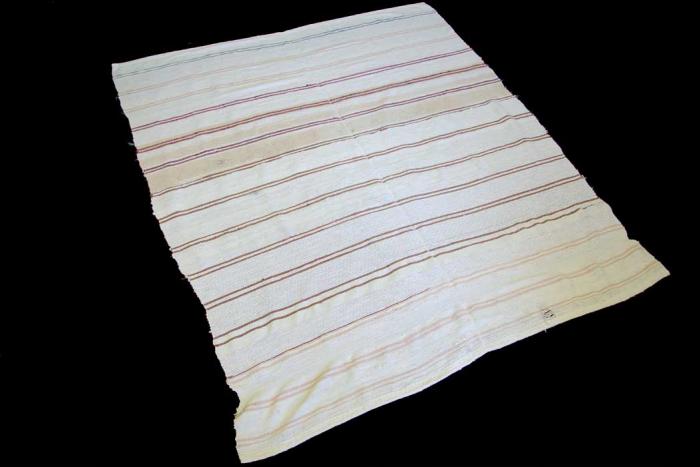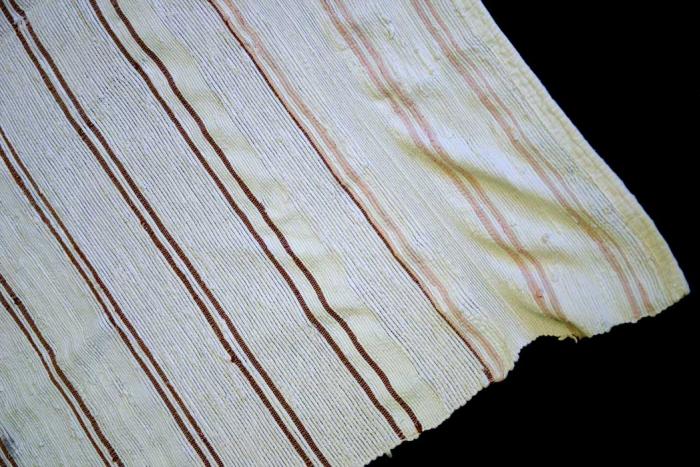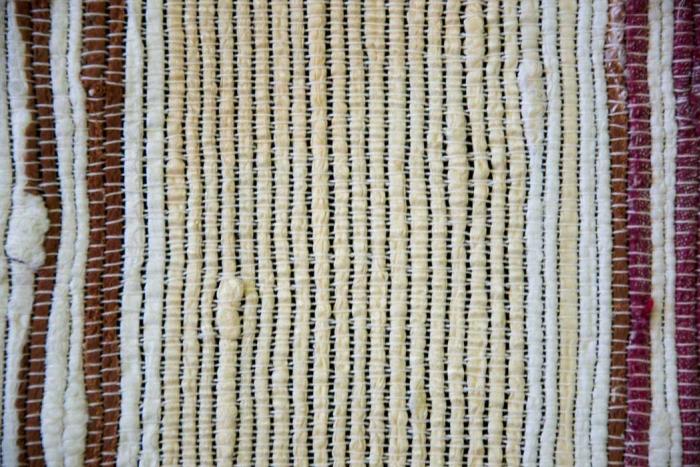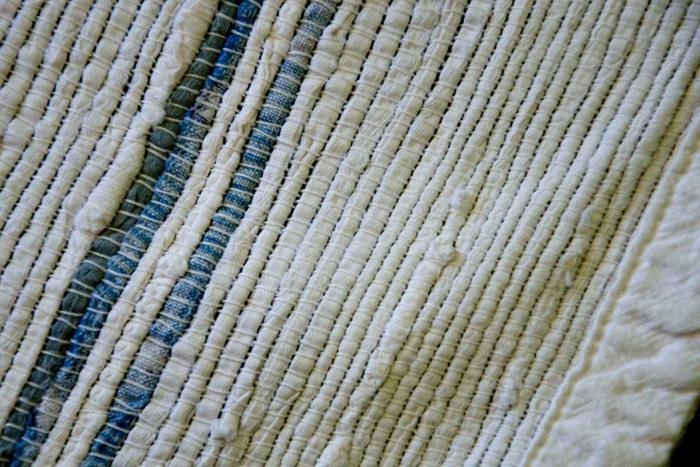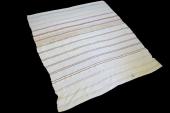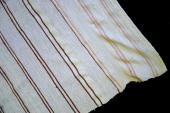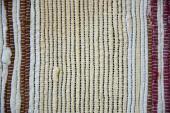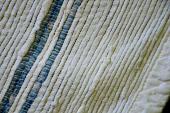Recycled Cloth Blanket
Organization: North Shore Community Association
Coordinates: www.quebecnorthshore.org
Address: 39 Marquette, Local 314, Baie-Comeau QC G4Z 1K4
Region: North Shore & Lower North Shore; Gaspé – Magdalen Islands
Contact: Jody Lessard, nsca(a)quebecnorthshore.org
Description: World War II era blanket made of recycled materials.
Year made: 1940s
Made by: Unknown
Materials/Medium: Recycled cloth
Colours: Off-white background with blue, red, brown and peach stripes
Provenance: Parc Forillon, Gaspé, Quebec
Size: 1.8 m x 1.7 m
Photos: Rachel Garber. Courtesy North Shore Community Association
Recycled Cloth Blanket
Jacqueline Hyman
“Nothing was wasted in those days…” wrote Lorraine Cameron Gray, daughter of Herbert Cameron, one of the first settlers of Baie-Comeau. She is the owner of this blanket woven of recycled cloth, made in the 1940s in Gaspé. Frugality and conservation were a way of life back then when money was scarce. Even if a family had money, goods were meagre and “it was not always possible to obtain new blankets.”
Many households had a blanket or two like this one, along with the frame for weaving. French-speaking families also recycled cloth in this way, calling the blankets “les catalognes.” During the long cold winters, the women would collect well-used clothing or other cloth that might otherwise be thrown away. The cloth was dyed, torn into strips, then woven into blankets. The blanket pictured here from that era is 1.8 metres x 1.7 metres. It is easily recognizable because of its striped design. On an off-white background, there were usually stripes, perhaps of red, or they might be green, grey, black, or yellow, running crosswise on the blanket. Clothing, aprons, pillow cases, table cloths, etc. would also be made from recycled cotton flour bags and sugar bags.
Lorraine Cameron Gray was given this particular blanket when she and her husband were a young married couple pastoring a church on the Gaspé. They would travel to the settlement of Grande Grève in present-day Parc Forillon every month or so to hold services in the home of Mr. and Mrs. Bertie Corbett. The Corbetts were an older couple who lived on a farm with no electricity. They were quite self-sufficient with a cow, pigs and chickens, and a vegetable garden. When their property was expropriated for Parc Forillon they moved to Fox River. One cold winter evening, the Gray's had their young child with them for the service and Mrs. Corbett gave Lorraine the blanket to keep her baby warm.
The tradition of frugality was strong in the English-speaking community of the region. Never a wealthy community, except for the well-to-do seasonal residents who visited many of the Saint Lawrence River shore communities, people always knew how to reuse and recycle. The effects of the Great Depression made these habits crucial to a family’s survival. In the 1940s, they were necessary to the war effort. Local organizations such as the Imperial Order of the Daughters of the Empire (I.O.D.E. de Gaspé), were often instrumental in organizing salvage efforts. Mrs. Gray recalls from her childhood in Baie-Comeau in the early 1940s that people would come around to the door to collect old cotton cloth, “even my father’s long-underwear,” to be recycled into useful articles. The cloth recycling was carried on before, during and after the War.
In 1941, the National Salvage Division of the Department of National War Services began a nation-wide salvage programme, asking households across the country to collect metals, paper, bones, rags and fat. Metals from old machinery, trucks and cars were recycled into airplanes, jeeps and tanks. Not only did this benefit the war effort but it cleaned up the countryside where worn out or broken implements had been abandoned. Paper was recycled to produce newspapers; bones were made into glue for airplane construction as well as being used in munitions. Housewives were even asked to save the fat from the cooking of meat and fowl for the making of dynamite. One pound of fat would make one pound of dynamite. Rags were collected for the making of army blankets and bandages.
The “green” or “eco-friendly” movements of today strive towards this same kind of resourcefulness, but are motivated more by global issues of resource conservation and anti-consumerism than by necessity. It is not surprising that these two objectives meet in the fabric arts. Consider what Sarah Bergman says about recycling cloth:
“An attraction to old fabric and clothing is a very common and powerful theme in fibre art in Canada and, in the world at large… Yet, the driving force behind the preference for old material goes deeper than just an artist’s belief that it is beautiful. Unlike the past, where the recycling of materials was out of financial necessity and resourcefulness, we are now compelled by new motivation to reuse fabric... We are surrounded by mass-production and cold, emotionless implements on a daily basis. This corporately dominated world does not always provide us with a sense of history or meaning.… Many Canadian fibre artists have taken up this responsibility, however small or largely conscious they are of their actions, and employ the use of recycled material in their work. Their work provides a more personal and intimate quality to our lives, as well as helping us work towards being more socially and environmentally aware.”
It is interesting to note that this blanket dates from the 1940s and that the donor recalls that fabric was still being collected in 1947 or 1948. After the war, people in many other regions forgot about recycling and reusing and returned to discarding used goods. Perhaps the continuing production of these blankets in Gaspé demonstrates both the continuation of economic distress and the habits of frugality of this community.
Sources
Information provided by Lorraine Cameron Gray
Sarah Bergman, "Salvaging Memories: Recycling in Canadian Textile and Fibre Art, Then and Now," Concordia Undergraduate Journal of Art History, 2008, Volume 5. http://art-history.concordia.ca/cujah/essay11.html
To Learn More
Ruth Roach Pierson, They’re Still Women After All: the Second World War and Canadian Womanhood, 1986.
Wartime Home Front, www.thecanadianencyclopedia.com
Canadian War Industry, www.canadaatwar.ca
Women and War on the Home Front, www.warmuseum.ca
Author
Jacqueline Hyman is a writer and lives in the Eastern Townships. She is a member of the Board of Directors of the Eaton Corner Museum in Cookshire-Eaton, Quebec.


